follow the fleet
Fred Astaire/Hermes Pan/Mark Sandrich
Follow the Fleet is the kind of film that had to wait for view-on-demand technology (which includes DVDs and even VHS tapes, as well as more recent innovations). Only a very odd viewer — one with a Navy fetish, perhaps — would rank it among the top five Rogers-Astaire movies, which means that revival houses would be loath to exhibit it except at festivals where the entire catalogue would be shown. If Follow the Fleet is showing at at a date and time in a movie theatre, the odds are small than many people are going to want to see it. But if it can be seen precisely when people happen to be in the mood — at home — then it comes across as a different picture. It's no longer stealing valuable time from the beloved titles — Top Hat, Swing Time, Shall We Dance, and so on. All of those can be watched precisely when people are in the mood, too.
The idea behind Follow the Fleet is to starve the film of glamour until the very end. Why would you want to do such a thing? Well, in 1936 there might have been any number of reasons for casting Ginger Rogers and Fred Astaire as just plain folks. Quite aside from synchronizing with the Depression, there is the curious phenomenon of reversed polarity: as Joe Blow, Astaire becomes the hard-to-get one, while Rogers takes over her partner's sunny disposition for a change.
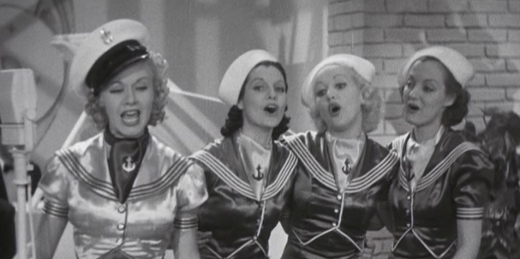
Nothing aloof about Ginger here, in the first of the film's two indisputable hit numbers, "Let Yourself Go." (That's Betty Grable in the middle of the backup group). And how about Fred, scheming about something at a fancy soirée, at which he is the only sorely underdressed guest:
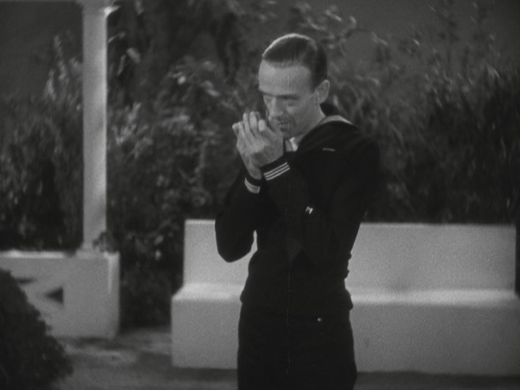
Pretty sinister, no?
Never mind the story. It folds back on itself so many times that it could be mistaken for puff pastry. And it doesn't end properly, either: Bake Baker (Astaire) rides off not into the sunset but back to a battleship where he'll be tossed in the brig. This seems about as worrisome to his lady-love, Sherry Martin (Rogers) as a parking ticket. We are at the antipodes from The Wrong Man.
But enough about Fred and Ginger — what about the other love interest? All the early vehicles have them, but this one is different. Instead of offering relatively low comic relief from the high comedy romance between the dancing stars, Follow the Fleet features a more serious romance, and an ambiguous one at that. At that swank soirée that I mentioned, here's Connie Martin (Harriet Hilliard — mother of David and Ricky Nelson), all tears and rhinestones, singing "But Where Are You?"
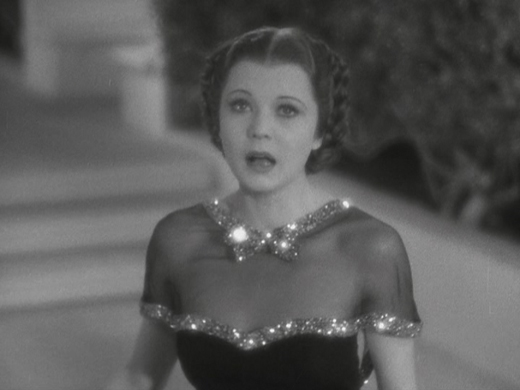
Where is he? He — "Bilge" Smith (Randolph Scott) — is right across the dance floor, arm in arm with mine hostess (Astrid Allwyn). The lady has just insulted Bake, but he hasn't registered it yet.
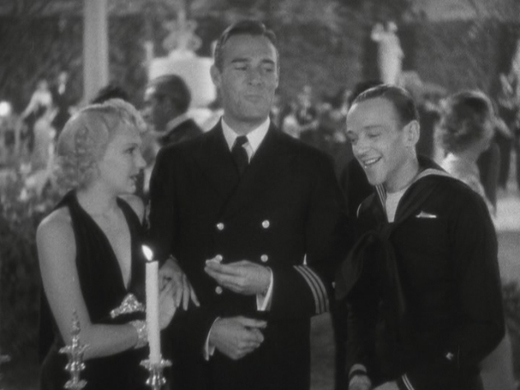
"Bilgie" ought to be over with Connie, and Bake will see to it that he gets there eventually, but it's a long row to hoe. Happily, Randolph Scott is quite fantastically awful as a dim and callow charmer. What Connie sees in him — ! But we can't go there. We can just enjoy the sap while it flows. Hilliard isn't awful, but she's terribly out of place, ruefully earnest at every turn. Although her initial makeover (from music teacher to belle of the ball) is impressive, her subsequent turnouts verge on the dowdy, and there's one fussy floor-length number that is not helped by an apron. The movie would have been ten times better if this role had gone to Lucille Ball, who also appears in the film (in a bigger part than she had in Top Hat). I don't believe that Scott and Ball are ever in the same frame; Mark Sandrich and his writers must have known better.
Fred and Ginger have a lot of fun, though. First of all, Bake and Sherry have a lot of fun together. This alone puts the film in a class by itself. Bake spends almost no time at all trying to sell himself to a reluctant lady. The Navy and its ways (which include sudden sailings from San Francisco) provides the impediments to true love's course. They have three good dances together and a solo each. Ginger's solo is as brief as Fred's is complex, but it's great giddy fun —
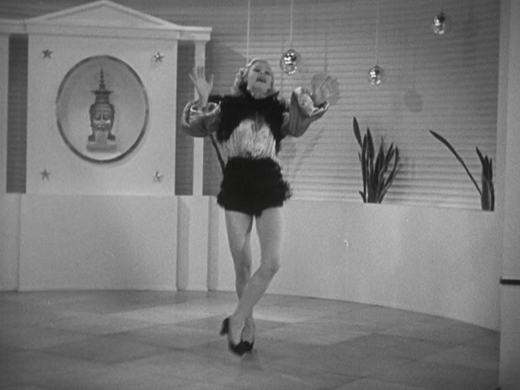
— and there's a wonderful little Latin number tucked into it. When you're in the mood for this sort of thing, only Follow the Fleet will satisfy.
I have never seen a still from "Let Yourself Go" that captures the demotic, almost street-swinging character of the dance. Suffice it to say that trousers make the woman, turning Ginger from the cupcake shown above into a true partner of Fred. As befits a number that is framed as a dance contest, "Let Yourself Go" is not about art-déco attitudes. The chart even picks up a take-out Chinese motif that echoes the dance hall's dime-store chinoiserie — all the funnier because this is one of the very rare Irving Berlin tunes that overtly draws on his Central European roots. If "Let Yourself Go" does not make you happy, see your doctor.
(Interesting plot twist: after dancing the audition shown above, Sherry is supposed to sing a song. Thanks to an identity mix-up and a tin of bicarb, Sherry winds up burping her way through a few bars of "Let Yourself Go," before abandoning the attempt as hopeless. Of all the songs!)
The big finish is, of course, "Let's Face the Music and Dance." This dramatic ballet, which begins with gambling losses and thoughts of suicide, is arguably the most finished ballet that Rogers and Astaire ever danced. How funny that it's tacked onto their most vernacular movie!
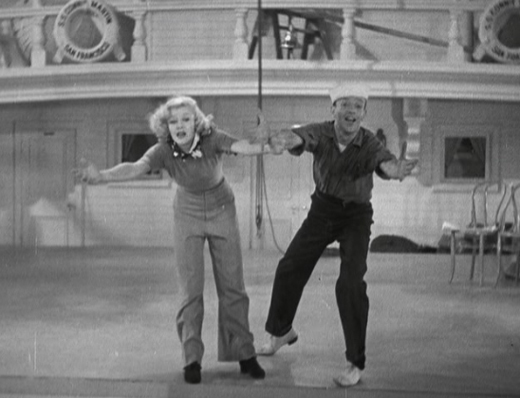
In between "Let Yourself Go" and the finale, Fred and Ginger have a comedy number, arbitrarily danced to "I'm Putting All My Eggs in One Basket," a song that ends with a fine bit of shameless hamming. Fans will recognize that a number of Ginger's funny bits resurface in the ineffable Funhouse scene in Damsel in Distress — a movie without Ginger. (Gracie Allen does the hoofing, and she's quite grand in her modest way.) Which reminds me: the only other one of Fred's dances — again without Ginger — that compares in élan with "Let Yourself Go" is the second half of the "Begin the Béguine" finale to Broadway Melody of 1940. Dancing while having a great time was, if anything, more natural to Eleanor Powell than it was to Fred Astaire; he's too much the perfectionist at times. That may be why the refrain of his most elated partnered dance is "Relax!" (August 2009)
Copyright (c) 2009 Pourover Press